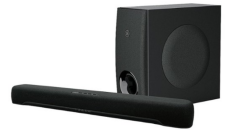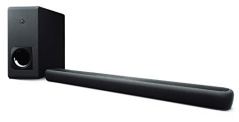Buying guide for Best Yamaha soundbars
TV audio has always posed a conundrum for users: we spend hundreds, sometimes thousands of dollars on cutting-edge 4K TVs, but the sound quality almost always sounds like an FM radio at best. For years, the best (and only) option was to connect an expensive multi-speaker surround-sound system to your TV — and that’s assuming you had the space for a ton of speakers in your TV room.
Thankfully, there’s now a better option: soundbars. Soundbars are flat, rectangular speakers designed to sit directly beneath your TV and provide higher-fidelity audio — and they’re much more affordable than multi-speaker alternatives. In fact, soundbars are so popular that practically every electronics manufacturer makes at least one model. One of the biggest names in soundbars is also one of the biggest names in home theater: Yamaha.
If you’re ready to get into the world of soundbars, or if you’re looking to upgrade your current soundbar to a more reliable brand, Yamaha’s are among the best available. The company makes soundbars to fit a variety of budgets, and the products deliver more dollar-for-dollar value than many competitors. Here’s everything you need to know to pick out the right Yamaha soundbar for your TV setup.
Key soundbar features
Different soundbars include a variety of features. These are the ones that matter the most.
Connectivity
First and foremost, you need to be certain you’ll be able to connect your TV’s audio to your soundbar, so pay close attention to connectivity options. For example, if you plan on using an optical cable from your TV to connect, make sure the soundbar you buy has an optical input. Similarly, if your TV doesn’t have an optical output and you want to use HDMI, make sure you buy a soundbar that has an HDMI input.
Subwoofer options
Some Yamaha soundbars come with external subwoofers, which are usually big, bulky boxes that you have to place elsewhere in the room. Some subwoofers are wireless; others need to be directly wired to the soundbar. If you want a lot of bass, look for a model with a big wireless subwoofer. If you want a soundbar but don’t want to bother your neighbors, buy one that includes built-in subwoofers.
Length
Soundbars come in all different lengths, but most people prefer to get one that’s roughly the same length as their TV for cosmetic reasons. Before you start shopping, take a moment to measure your TV’s footprint, and keep those dimensions in mind when comparing soundbars.
Supported audio formats
TV and movie audio comes in a variety of different formats, ranging from basic two-channel stereo to cutting-edge formats like Dolby Atmos and DTS:X. Take a moment to consider which audio formats you use most, and make sure the soundbar you buy supports them. For example, if you’re planning on connecting your cable box, you’ll need one that supports Dolby Digital 5.1 audio, but if you’re planning on connecting a 4K Blu-ray player, you may want a soundbar that also supports common 4K audio formats like Dolby Atmos.
Voice control
Remote controls are great — until you lose yours. If you’re tired of digging through the couch cushions to find your remotes, or if you’re looking to integrate a digital assistant like Amazon’s Alexa, get a soundbar that includes voice control. With voice control, you can easily use verbal commands to power your soundbar on and off or even change the volume.
Yamaha soundbar prices
Soundbar prices vary depending on feature set. Here’s what you need to know about the different price ranges.
Inexpensive
Between $50 and $199, you’ll find a mix of budget model soundbars. Soundbars in this price range don’t usually include a subwoofer and are often not loud enough for TVs larger than 42 inches. If you just need a basic soundbar for a secondary TV or a similar situation, you don’t need to spend more than this. But if you’re outfitting your primary TV, consider spending a little more.
Mid-range
Between $200 and $399, you’ll encounter the best values in Yamaha soundbars. Models in this price range offer a good balance between key features (like a wireless subwoofer or Bluetooth connectivity) and overall price. At the low end of this price range, you’ll find great models for any home. On the higher end, you’ll find more niche features and soundbars powerful enough to fill a large room.
Expensive
Between $400 and $1,600, expect to see the cream of the crop: soundbars that include every feature available and are built with premium finishes. Only a handful of models are this expensive, but if you want the best sound available and don’t have a lot of room, you’ll need to pay a lot more.
Tips
Before you buy a soundbar, go over your existing TV setup to make sure you know your specific connectivity needs. There are a few different ways to get audio from your TV components to your soundbar, and you’re going to need one that can easily connect with your setup. Decide how you’re going to set up your soundbar: are you going to connect it to your TV with an optical cable, or are you going to connect it to both your cable box and your TV with HDMI cables? Once you’ve determined how you want it all to work, make sure the soundbar you buy supports your ideal connectivity options (and don’t forget to buy extra cables if you need them).
If you buy a Yamaha soundbar with a subwoofer, experiment with putting the subwoofer in different locations throughout the room. Subwoofer audio is directionless, so you don’t have to be in front of one to hear sound from it. But that doesn’t mean it doesn’t benefit from ideal placement. Pick your favorite bass-heavy track or explosion-filled movie, and run some tests with the subwoofer in various locations. You may be be surprised at how much a well-placed subwoofer can improve your TV-watching experience.
- Make sure the soundbar you buy has an auto shut-off feature. Soundbars need to be plugged in, and in most cases, that means that when you turn your TV off, you need to turn the soundbar off separately. It’s easy to forget to turn the soundbar off once you’ve powered down your TV, so pick up one that has an auto shut-off feature. This could help you save on your electric bill.
FAQ
Q. How is it that some soundbars claim they can produce surround sound without using additional speakers?
A. Many soundbars actually have multiple speakers inside, often pointed in different directions. In these cases, the soundbar is often capable of projecting surround sound audio (like ambient sound effects or music) with different speakers, bouncing it off of the floor and walls. The result: in the right environment, a lot of soundbars can mimic surround sound, creating convincing, immersive audio. While a soundbar will never deliver quite the sound separation that a proper multi-speaker home theater environment could, it can still turn any TV room into a mini-home theater.
Q. Do I have to have an audio-video receiver to use a soundbar, or can I just plug one into my TV?
A. Soundbars have built-in amplifiers, so they don’t need to be connected to another amplifier like an audio-video receiver. Soundbars typically connect to TVs directly via HDMI cables or through optical audio cables.
Q. What separates Yamaha soundbars from the competition?
A. In the home theater market, Yamaha has developed a name for itself as a producer of quality equipment, but it’s the company’s affordability that makes it unique. In many cases, finding a better-sounding option than a Yamaha would mean paying twice as much.























